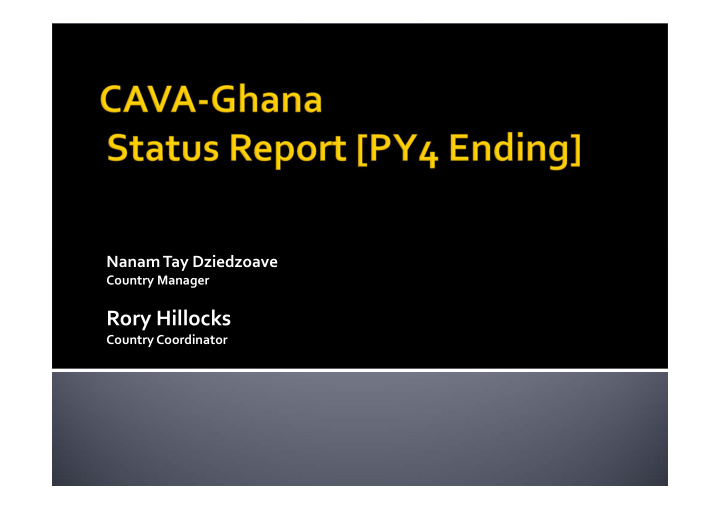



Nanam Tay Dziedzoave Country Manager Rory Hillocks Country Coordinator
By 2013, 5,000 farmers (30% women) in project target areas benefit by an average of: ▪ $ 81 per year from sale of fresh roots (2 t each) to processors of cassava products (fufu, gari and low quality cassava flour). A further 5,000 farmers benefit by $70 per year from sale of cassava roots to bin dryer .operators for HQCF production.
Facilitating Linkages of Existing Farmer Groups to viable markets for cassava sales Formation of New Farmer Groups for access to training and agronomic support Facilitating Linkages of New Farmer groups to Viable Markets for cassava sales
Strengthening Linkages of SSEs and SMEs to viable markets for sale of HQCF and cassava products. Promotion of HQCF production, utilisation & marketing. Building capacity of end users to utilise HQCF and other cassava products.
PRODUCTION FARMERS FPs TOTAL Number of groups 581.00 95.00 676.00 Total area of group farms (acres) 4,987.50 95.50 5,083.00 Number of group members 12,908.00 909.00 13,817.00 Total area of members’ farms with improved cassava (acres) 8,192.24 919.26 9,111.50 Cassava roots sold for HQCF (tons) 3,315.32 948.47 4,263.79 Cassava roots sold for other markets (tons) 21,018.25 1,585.00 22,603.25
PROCESSING- FPs FPs SMEs TOTAL Quantity of cassava roots bought (tons) 50,793.80 14,884.09 35,909.71 From C:AVA farmer groups 29,488.68 12,105.79 17,382.89 From other farmers 21,305.12 2,778.30 18,526.82 Quantity of wet cake sold (tons) 2,254.00 1,009.00 1,245.00 Quantity of high quality grits sold (tons) 208.98 56.80 152.18 Quantity of HQCF sold (tons) 2,048.92 512.00 1536.92 Quantity of traditional cassava products sold* (tons) - Gari 7,006.31 1,603.00 5,402.82 Kokonte 893.10 708.70 184.40
Performance by MLSEs Total ($) Total Deposit at Holding Bank 190,751.70 Committed funds 154,469.00 Defaults Paid to lending Bank 5,714.00 Defaults yet to be paid to lending bank 21,429.00 Expected Balance after payment of defaults 163,608.7
Quantity Type of product Number of Type of Market Supplied supplied Clients (TONS) HQCF 2 112.95 Biscuit Industry MIXED 23 1,471.12 Food industry HQCF 1 79.03 Mosquito Coil Industry HQCF 1 1.3 Paper industry HQCF 11 490.75 Plywood Industry MIXED 1 30.1 Poultry Industry MIXED 2 14.45 Unknown TOTAL 41 2,200.49
SOURCE OF BENEFIT TYPE OF BENEFFICIARY NUMBER OF BENEFICIARIES Sale of Cassava + Wet cake CAVA Farmers 14,744 Sale of Cassava Non ‐ CAVA Farmers 10,653 Working at processing site Paid Workers at Processing 1,619 sites Working on Farms Paid workers at Farms 6,245 Access to raw material End Users of Flour 41 supply Access to credit Medium Scale Processors 8 Access to markets Small/Medium scale 33 processors TOTAL NUMBER OF BENEFICIARIES 33,343
REVISED MILESTONES TARGETS ACHIEVEMENTS March 2013 March 2011 March 2012 Farmers selling roots for flash ‐ dried HQCF 3,150 582 Farmers selling wet cake for flash dried HQCF 142 0 Farmers selling roots for bin dried HQCF 5,000 995 13,052 Farmers selling roots for alternative drying nil systems 9,809 Farmers selling roots for Local cassava 8,232 5,137 products Community processors serving bin dryer 225 Not assessed 237* operators Community processors producing Local 1,151 Not assessed 396* cassava products. *Estimates based on the assumption that each community processor processses 4tons of cassava
MILESTONES TARGETS ACHIEVEMENTS March 2013 March 2011 March 2012 Flash dryer units installed 2 0 0 Working capital financing of 25 8 1 processors Additional employment 400 Not assessed 1,619 Production of HQCF 4075 1175 2048.92 Purchase of HQCF 4075 1175 2048.92
National Composite Flour Committee Inaugurated – Report due June/July. CAVA ‐ Ghana playing key role Promotion of HQCF for domestic use Workshop for hotels and restaurants by ASRuD. Workshop for women groups and religious organisations by PROYCOD
Collaboration with WAAPP to train bakers and matrons of SHS in Western and Central Regions. 24 Schools trained 60 community bakers trained Almost 1 ton of HQCF supplied within 6 ‐ month period. Commercial Companies getting interested in large scale cassava production for industrial starch. Ghaceram Agro Development Company Supercare Ghana Ltd.
Processors abusing payment terms agreed with farmers. Lack of trust between farmers and processors leading to non ‐ signing of MOUs Processors no longer interested in the LPG. Difficulties in the collection of accurate data at community level on quantity of roots sold. Record keeping at some processing plants still a problem.
Lack of physical capacity still a problem. Lack of retail outlets for HQCF for small scale users. Quality of products not adequate: high fibre, poor colour, bad odour, fermented pdt., etc. Farmers not willing to join groups because of lack of a visible benefit – no financial assistance, and no markets. Pricing still a big challenge Contributory factor to quality challenges.
Channeling loans through Rural banks does not appear to be a very effective project strategy. Focusing financial investments on processors is a more effective way of driving the value chain Absence of some minimal financial assistance to farmers limits their interest in project activities. Inability to keep faith with farmers generates a lot of mistrust which is carried over to other projects
Failure of LPG due to narrow perception of causes of ‘lack of access to credit’ as lack of collateral. Current understanding of credit needs of processors reveals issues including: Need for low interest working capital loans Need for low interest loans for fixed assets Need for longer repayment periods for fixed asset loans, as well as, Collateral for loans
THANK YOU
Recommend
More recommend